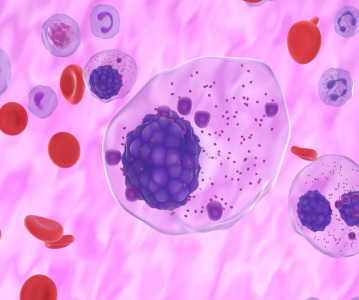Regeneron and Sanofi Announce Positive Pivotal Phase IIb Dupilumab Data in Asthma

Regeneron Pharmaceuticals and Sanofi haveshared positive results from an interim analysis of a pivotal Phase IIb study of dupilumab in adult patients with moderate-to-severe asthma, who are uncontrolled despite treatment with inhaled corticosteroids and long-acting beta agonists (ICS/LABA).
As previously reported, the study met its primary endpoint of improving lung function in asthma patients with high blood eosinophil counts (HEos, greater than or equal to 300 eosinophilic cells/microliter). Such high counts are thought to be a marker for patients more likely to have "atopic" or "allergic" asthma. New data presented on secondary endpoints at the American Thoracic Society 2015 International Conference included positive results in study patients with low blood eosinophil counts (LEos, less than 300 eosinophilic cells/microliter), who are thought to be less likely to suffer from "allergic" asthma and thus less likely to respond to TH2 targeted therapies. Dupilumab is an investigational therapy that inhibits signaling of IL-4 and IL-13, two cytokines required for the TH2 (or Type 2) immune response.
Based on discussions with the FDA, this Phase IIb study may be considered one of two pivotal efficacy studies required for a potential dupilumab biologics license application (BLA) in asthma. The companies also announced the initiation of a Phase III clinical trial of dupilumab in patients with uncontrolled persistent asthma, known as LIBERTY ASTHMA QUEST, which will serve as the second required pivotal efficacy study. The global, placebo-controlled Phase III study will enroll more than 1600 patients with uncontrolled persistent asthma and will evaluate two doses of dupilumab, 200 mg and 300 mg, subcutaneously administered every other week (Q2W).
The new results focused on LEos asthma patients. In this population, patients treated with either 200 mg or 300 mg Q2W doses of dupilumab showed a greater than 8% improvement in forced expiratory volume over one second (FEV1, a standard measure of lung function) at Week 12 (p less than 0.001), in comparison to placebo, both in combination with ICS/LABA. Additionally, the 200 mg and 300 mg Q2W doses of dupilumab in combination with ICS/LABA showed 68% and 62% reductions, respectively, in adjusted annualized rate of severe exacerbations in the LEos population (p less than 0.01 and p less than 0.05), in comparison to placebo in combination with ICS/LABA.
These results are consistent with previously reported positive results in HEos asthma patients and the overall patient population, in which the two Q2W doses (200 mg and 300 mg) of dupilumab in combination with ICS/LABA demonstrated a statistically significant 12–15% improvement in FEV1 over placebo at Week 12 and a 64–75% improvement in annualized rate of severe exacerbations over placebo.
Dupilumab also significantly reduced mean fractional exhaled nitric oxide (FeNO) across both Q2W doses tested (200 and 300 mg) and the three patient populations (overall, LEos and HEos), in a roughly dose-dependent manner. FeNO is recommended by the American Thoracic Society clinical practice guidelines to assess airway inflammation, since higher than normal levels of nitric oxide may be released when a patient has a chronic airway disease, such as asthma.
"Despite available treatments, many patients with asthma continue to have symptoms and recurring attacks, which have a serious and detrimental impact on their daily lives," said Sally Wenzel, lead investigator from The University of Pittsburgh, Division of Pulmonary, Allergy and Critical Care Medicine. "In the study, dupilumab added to standard-of-care therapy demonstrated fewer exacerbations and improved lung function across both the high and low baseline eosinophil groups. We look forward to the continued clinical development of dupilumab as a potential option for a broad population of patients with uncontrolled asthma."
Related News
-
News BioNTech to begin mRNA vaccine manufacturing in Rwanda by 2025
German biotechnology company BioNTech has stated their intentions to begin production at their mRNA vaccine factory in Rwanda by 2025, which will mark the first foreign mRNA vaccine manufacturing site on the continent of Africa. -
News Identifying Alzheimer’s Disease biomarker proteins with whole blood tests
A University of Manchester spin-out pharmaceutical company, PharmaKure, has reported successful study results for the quantification of Alzheimer’s Disease biomarker proteins with a whole blood test. -
News Bill & Melinda Gates Foundation to boost mRNA vaccine initiatives in Africa with USD $40m
To address vaccine inequality and accessibility issues, the Bill & Melinda Gates Foundation aims to deliver USD $40m to various biotech companies and vaccine manufacturers in support of mRNA vaccine development. -
News CPHI Podcast Series: Exploring neurological frontiers in Alzheimer's and beyond
The next episode of the CPHI Podcast Series delves into the science and background behind some recent developments in the field of Alzheimer's disease and neurological disorders. -
News Is patient centricity the future of pharmaceutical manufacturing?
In this interview with Sandra Sánchez y Oldenhage, President of PharmAdvice, she speaks to the importance of considering patients in the manufacturing stages of the pharmaceutical supply chain, and how it can redefine healthcare. -
News CPHI Podcast Series: How to leverage AI for Drug Discovery
Artificial intelligence is the topic of debate in the latest episode from the CPHI Podcast Series, where Digital Editor Lucy Chard speaks with Bill Whitford of DPS Group about the integration of AI in healthcare. -
News Pfizer forges ahead with blood cancer therapy after approval from FDA
Pfizer gains accelerated approval from the US FDA for their new bispecific antibody therapy for multiple myeloma, set to address an unmet need for patients. -
News Alzheimer's drug donanemab deemed effective in landmark clinical trial
Results from the TRAILBLAZER-ALZ 2 Randomised Clinical Trial into the use of donanemab to treat early symptoms of Alzheimer’s disease have been analysed.
Position your company at the heart of the global Pharma industry with a CPHI Online membership
-
Your products and solutions visible to thousands of visitors within the largest Pharma marketplace
-
Generate high-quality, engaged leads for your business, all year round
-
Promote your business as the industry’s thought-leader by hosting your reports, brochures and videos within your profile
-
Your company’s profile boosted at all participating CPHI events
-
An easy-to-use platform with a detailed dashboard showing your leads and performance







